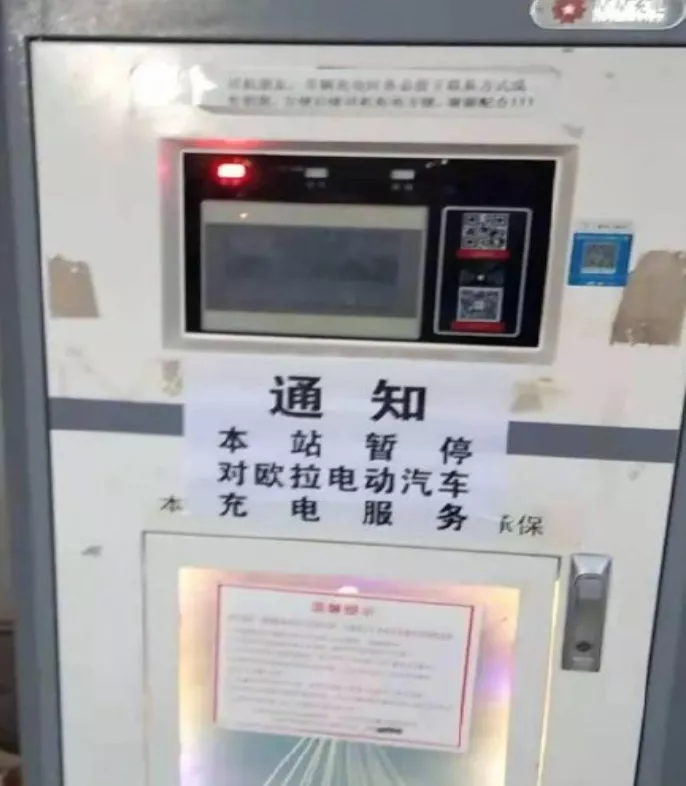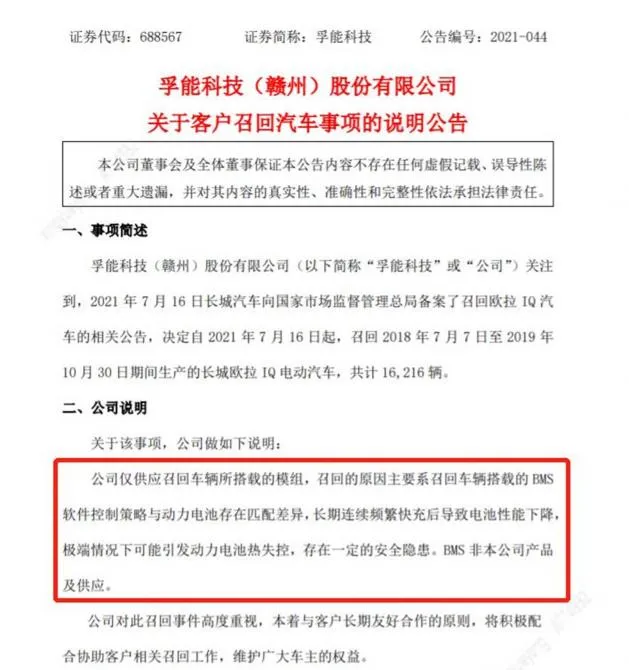Author: Shikangrong
Did the EulaiQ catch fire while charging? Great Wall Motors urgently recalls the EulaiQ? Both fire incidents and the recall have suddenly dragged EulaiQ, a rapidly developing new energy vehicle brand, into the abyss.

The development of new energy vehicles is in good shape. In addition to emerging electric vehicle companies, traditional companies have also begun to launch their own electric vehicles in accordance with the development of the times. It is worth encouraging and promoting to follow the development of the times. However, is it more important to pay attention to battery safety issues hidden under the good situation of new energy vehicles?
“We need not only an electric car, but also a safe electric car that will not catch fire while charging and can provide basic protection for family, friends, and even strangers.”
However, when facing the call for safety from users and the doubts of people in the new energy industry, controversies and doubts about the battery used in EulaiQ are rapidly gathering.
What is the truth about the EulaiQ catching fire?
Recently, a notice was circulated on the Internet that a certain charging station banned Eulai brand electric vehicle charging, which caused intense discussion in the new energy vehicle circle.
It is reported that during the charging process, several fire incidents occurred in the EulaiQ under the Great Wall. On July 16th, Great Wall Motors filed a recall notice for the EulaiQ car with the State Administration of Market Supervision, and decided to recall a total of 16,216 Great Wall Eulai IQ electric vehicles produced from July 7, 2018 to October 30, 2019, starting from that day.
Earlier, some netizens speculated that the battery used in the Eulai IQ that caught fire came from CATL, but after CATL quickly issued a clarification announcement, the market turned its attention to Funeng Technology.
Funeng Technology, as the lithium-ion battery manufacturer at the center of public opinion, is also at the center of the storm, and for a time, there were widespread doubts about Funeng Technology on the internet. Some netizens said: “If the battery causes the car to catch fire, who dares to charge it in the future? Is Funeng really making products with good intentions?” and “I wouldn’t dare to buy products that use their batteries”.
In response to the hot discussion online, Funeng Technology responded and explained for the first time that the company only supplies modules carried by the recalled vehicles. The main reason for the recall is the mismatch between the BMS software control strategy carried by the recalled vehicles and the power battery, which can cause a decline in battery performance after long-term and frequent fast charging, and extreme cases may cause thermal runaway of the power battery, resulting in certain safety risks. The BMS is not a product or supply of our company.
 ## What is BMS?
## What is BMS?
BMS, also known as Battery Management System, is mainly for intelligent management and maintenance of various battery cells to prevent overcharging, over-discharging and overheating of batteries, and to monitor the battery status. The functions include measuring battery voltage, ensuring its normal operation, monitoring current, temperature, etc.
Although FUDI Tech has responded to the cause of the spontaneous combustion of Euler IQ and claimed that it was not the fault of the battery but the mismatch between BMS and its own battery, netizens seem to be skeptical of this statement. The questioning voice of “FUDI Tech shirks responsibility for battery spontaneous combustion” has not disappeared, but has instead intensified.
Subsequently, Great Wall Motors stated that the emergency recall of Euler’s spontaneous combustion incident was only related to the control strategy of BMS, which was jointly developed and verified by Great Wall Motors and FUDI Tech. Therefore, based on the responses given by both parties, the responsibility for the incident is still unclear.
Who will pay for battery safety?
With the rise of the new energy vehicle industry, “battery” is the most important challenge in addition to technological innovation and transformation.
How to manufacture and install ultra-large capacity batteries for electric vehicles? How to reform fast charging technology and update the charging system? In more detailed analysis, how to choose the appropriate battery for the product and how to define battery standards? Any loophole in any of these links may potentially cause safety accidents in the car itself.
Among them, battery safety hazards occupy a major position. According to industry data, the frequency of self-ignition accidents caused by battery factors is the highest among new energy vehicle self-ignition causes.
With the widespread application of new energy electric vehicles, the capacity, safety, health status and cruising ability of batteries have become increasingly important. Currently, batteries are the main bottleneck in the development of new energy vehicles. However, the first step in successfully overcoming the bottleneck is to solve the problem of battery safety. For electric vehicle users, battery safety is also the primary concern.
It is reported that the new version of the Three Guarantees Regulations has added relevant regulations on “repair, replacement, and return” for new energy vehicle failures such as the power battery. For household car products, if the power battery or its major components need to be replaced due to quality issues within 7 days from the effective date of the Three Guarantees period, they can be replaced or returned free of charge.
Therefore, for companies that want to develop the new energy electric vehicle market, it is even more important to pay attention to battery safety hazards. This is not only a strategic decision-making problem for one company but will also affect concerns and concerns in the industry about the development of new energy vehicles.
Why do more electric vehicle manufacturers choose to develop their own batteries and charging systems with great effort? One theory is to avoid “misfits” and prevent “repulsion” occurring, which could cause battery spontaneous combustion accidents, such as that happened to Euler this time.Another way of saying is that the current government strongly supports the R&D of new energy battery systems for enterprises. Encouraged by national policies, funding can be supported. Although it takes a long time, in the future, at least the products are reliable and have no disputes. The responsibility is more direct.
The Euler iQ incident is not the first self-burning accident of new energy electric vehicles. Recently, Chery was also deeply involved in the battery crisis, which indicates that the hidden danger of battery safety has been buried for a long time.
Electric vehicle companies cannot turn a blind eye to this, and battery manufacturers cannot shirk their responsibilities. For the vast number of users, “what we want is not only an electric car, but also a safe electric car that will not burn when charging and can provide basic security for family, friends or even others.”
This article is a translation by ChatGPT of a Chinese report from 42HOW. If you have any questions about it, please email bd@42how.com.